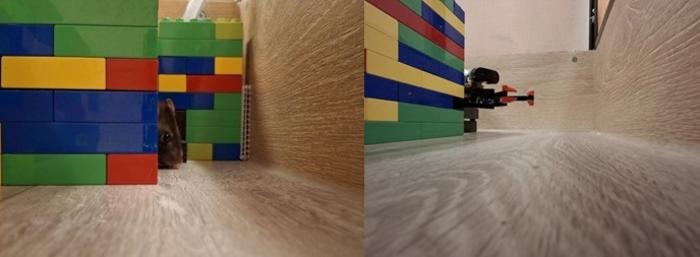image:
A rat peeking around a corner is concerned about the robot at the end of the hall.
view more
Researchers find that rats create neurological maps of places to avoid after experiencing a threat and think about these locations when exhibiting worry-related behaviors. These findings—which A. David Redish of the University of Minnesota, US, and colleagues presented in the open-access journal PLOS Biology on January 14th—may provide insight into the neuroscience of common psychological conditions like anxiety.
There are many theories as to why people experience anxiety. One is that anxiety is associated with a psychological phenomenon called “approach-avoidance conflict,” where an individual desires something but is weighing that against an associated negative outcome.
To examine the neurological underpinnings of this phenomenon, researchers studied rats navigating an L-shape track. The rats would enter at one end, with food available at the opposite end of the track, but partially hidden around the corner would be a robot with claws on the front and a stinger-like tail, somewhat resembling a cross between a pincer beetle and a scorpion.
As the rats approached the food, the robot would sometimes charge forward and gnash its claws and wriggle its tail to simulate an attack. After these attacks, the rats began performing avoidant behaviors, like hesitating or fleeing back to safety, which the researchers propose are associated with worry about the robot.
Some of the rats in the experiment were implanted with probes to monitor the hippocampus, part of the brain thought to be involved in learning and memory. The researchers specifically focused on the activity of neurons called “place cells,” which activate when an animal visits a specific location. By scrutinizing their activity, the researchers could map which place cells were associated with the location of the food or of the robot.
When the rats hesitated while approaching the food, the researchers found increased activity in the place cells associated with the location of the robot and of the food. This may represent the approach-avoidance conflict between wanting the food and worry about the robot. However, when the rats turned around part-way down the track, the active place cells were mainly associated with the location of the robot.
Usually, place cells are only active when the cells’ associated location is the animal’s location or just ahead of the animal. However, as the rats turned around and fled back to the safe end of the track, their place cells associated with the distant robot remained active.
Anxiety is related to the ability to imagine situations, something the hippocampus and place cells are known to be involved in. The activity of place cells associated with negative events—especially when at a distance from their associated locations—may help scientists better understand the neuroscience of anxiety.
Underlining this association, the researchers observed far fewer worry-related behaviors among the rats when given the anti-anxiety drug diazepam, commonly known as Valium. This medication also altered the activity of the hippocampus, reducing the neural patterns associated with these anxiety-like behaviors.
The authors add, “Worrying about the future requires mental representations of imagined negative future outcomes. Rats facing a predator-like robot guarding a food source developed new mental representations of the robot’s location, resulting in rats transiently thinking about where the robot is prior to foraging for food.”
In your coverage, please use this URL to provide access to the freely available paper in PLOS Biology:
Citation: Calvin OL, Erickson MT, Walters CJ, Redish AD (2025) Dorsal hippocampus represents locations to avoid as well as locations to approach during approach-avoidance conflict. PLoS Biol 23(1): e3002954.
Author Countries: United States
Funding: This work was funded by grants from the US National Institute of Health: R01-MH080318 (ADR), R01-MH112688 (ADR), a T32 fellowship to OLC (T32-DA037183), a T32 fellowship to CJW (T32-DA007234), summer project funding from St. Olaf College to MTE, and funding from the University of Minnesota Medical School. The funders had no role in study design, data collection, and analysis, decision to publish, or preparation of the manuscript.
Journal
PLOS Biology
DOI
10.1371/journal.pbio.3002954
Method of Research
Experimental study
Subject of Research
Animals
COI Statement
Competing interests: The authors have declared that no competing interests exist.
Media Contact
Claire Turner
PLOS
Journal
PLOS Biology
DOI
10.1371/journal.pbio.3002954
Method of Research
Experimental study
Subject of Research
Animals
COI Statement
Competing interests: The authors have declared that no competing interests exist.
bu içeriği en az 2000 kelime olacak şekilde ve alt başlıklar ve madde içermiyecek şekilde ünlü bir science magazine için İngilizce olarak yeniden yaz. Teknik açıklamalar içersin ve viral olacak şekilde İngilizce yaz. Haber dışında başka bir şey içermesin. Haber içerisinde en az 12 paragraf ve her bir paragrafta da en az 50 kelime olsun. Cevapta sadece haber olsun. Ayrıca haberi yazdıktan sonra içerikten yararlanarak aşağıdaki başlıkların bilgisi var ise haberin altında doldur. Eğer yoksa bilgisi ilgili kısmı yazma.:
Subject of Research:
Article Title:
News Publication Date:
Web References:
References:
Image Credits:
Keywords





